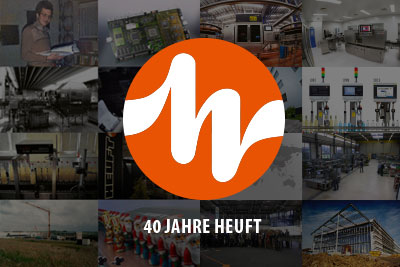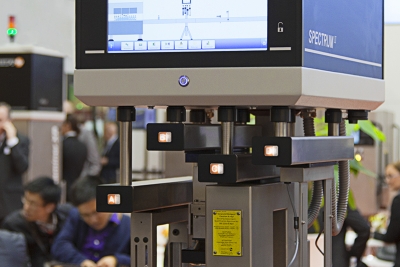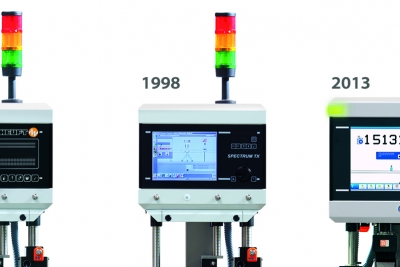Simply different, simply better!
Part 1 of our new series for the 40th company anniversary examines the basic technological concepts and milestones which have made HEUFT SYSTEMTECHNIK GMBH the leading manufacturer of innovative quality control, in-line inspection and labelling systems for the beverage, food and pharmaceutical industries.

„There must be another way of doing this but there must also be a better way“. This was the keynote, right from the start, according to which HEUFT has continued to advance in-line quality assurance along filling and packaging lines over the last 40 years. It would go beyond the scope of this article to list all the pioneering achievements here separately: the sheer number of patents granted since the company was founded is well over 500! However three major basic developmental concepts which have made HEUFT the technology leader in the long term can be clearly identified: firstly more automation. Secondly more support and assistance for the operator. And thirdly, of course, more precision when detecting and rejecting faults!
1. More automation!
HEUFT began to replace the random in-line quality inspection by eye which was still common at that time with microprocessor controlled counting, sorting and control devices as early as 1979. For example with the first solution for an exact optical examination of the fill level of each individual bottle. But the best detection is of no use if the incorrectly filled containers are not also removed from the production flow. And not manually but automatically – accurately and carefully. The solution: the ingenious multi-segment principle of the HEUFT DELTA-FW flow rejector which was already patented in the year HEUFT was founded! Several rejection fingers which can be pneumatically retracted and extended individually form a curve which removes each faulty bottle from the line upright and without wobbling but leaves the adjacent good containers there. It has only been slightly modified but it still defines the state of the art today regarding the automatic high-speed rejection of faulty empty and full containers. It was also important to uncover the causes of the quality defects detected at an early stage and without human intervention: a specially developed locator function already carried out something similar in 1980 by automatically determining the filler valve responsible for the filling error detected. Therefore what others are only turning into a trend today was already possible at that time: preventive maintenance.

The next step in automation was taken with the universal HEUFT SPECTRUM device platform introduced in 1987 which was multiprocessing capable, had its own CPUs and proprietary operating system for the individual combination of the most varied detection units for all possible requirements and applications in one and the same device – and at the same established the modular design principle for genuine HEUFT system technology which is upwardly compatible at all times. This paved the way for innovative devices in a resource efficient straight-through system such as the world's first linear empty bottle inspector launched in 1991. They not only use significantly less space than conventional carousel machines. In addition they do not need product-specific, wear-intensive change parts which reduces set-up times during brand changes as well as the total amount of maintenance required. 1995 saw the first HEUFT synchron conveyor control system which ensures a gentle, harmonious container transport and an even supply to the master machines as if automatically. Then at the turn of the century automatic production data acquisition and remote maintenance are possible with the HEUFT SPECTRUM TX the first network-compatible central control unit for modular systems such as the top-selling HEUFT InLine for an all-surface inspection of empty bottles on less than one square metre of floor space or the first labelling machines with integrated fault detection. The integrable servo technology which follows shortly for the automatic adaptation of container transport and detection units already carried out brand changes at the push of a button before the introduction of the HEUFT SPECTRUM II device platform to the market in 2013 which is even more highly automated, truly intelligent and practically self-explanatory.:
2. More support and assistance for the operator
The audiovisual HEUFT NaVi user guidance makes the operator a competent user. On the rare occasions when he has to take action it is explained to him in words, pictures and sound step by step and shown in detail what has to be done where and how. He can therefore restore full operational reliability without a great deal of prior knowledge. This marks the provisional peak of the second basic developmental concept which HEUFT has promoted from the very beginning: as much overview, assistance and support for the operator as possible!
Therefore the company had already introduced something to the damp bottling hall three years after it had been founded that had previously only been known from the TV at home: devices with a CRT monitor. Initially this caused raised eyebrows in the industry but the innovation which informs and relieves the operator quickly gained popularity. The systems from the modular HEUFT SPECTRUM series available since the early 1990s already had screens as standard. The HEUFT PILOT a self programmed graphical user interface offering the operator even more overview and orientation is added less than ten years later with the HEUFT SPECTRUM TX. And the network interface which has been integrated since then reduces the effort required for line analysis and maintenance: essential operating, production and quality data are automatically recorded and evaluated with the HEUFT PROFILER introduced in 2002. In addition remote diagnosis and maintenance is possible for the first time with the HEUFT TeleService. It was even possible to centrally manage and convert the brands and recipes to be processed by HEUFT SPECTRUM II devices as from 2015. These create full transparency and genuine know-how automatically with large touchscreens and the HEUFT NaVi user guidance including groundbreaking HEUFT checkPoints and audiovisual step-by-step assistance.
3. More detection and rejection reliability
This alone ensures the high availability of the modular HEUFT SPECTRUM II systems. Their precision during product tracking with millimetre accuracy has quadrupled compared to the previous generation due to new, even more powerful CPUs for a significant increase in computing power. The in-line inspection of each individual product and the rejection of each faulty product are therefore also more accurate. The detection and rejection reliability continue to increase with the HEUFT reflexx² the current version of the in-house developed image processing system. It combines camera and X-ray images in real time into high-resolution, noise-free detection pictures and carries out a reliable object detection as did its predecessor which was introduced more than 15 years ago in 2002. A new feature is the targeted classification of the identified objects for maximum detection reliability with a minimum false rejection rate.

Only removing really faulty empty and full containers: this was one of the most important HEUFT development targets from the start. Optimum detection quality is decisive for this purpose besides powerful sensor technology not only for precise container tracking. This was already achieved in 1979 with the first optical fill level detection mentioned above. But only for transparent containers. An appropriate solution with high-frequency technology in order to be able to check the filling quantity of opaque packaging materials as well followed in 1981 a few years before the introduction of special X-ray measuring bridges. It also uses the module launched at the same time for detecting residual lye which still ensures the integrity of returnable empty bottles today – practically unchanged: the HEUFT fluid.
It contributes to a reliable fault identification when examining empty bottles together with sophisticated optics for a precise, comprehensive base, sidewall and finish inspection which HEUFT made possible with the linear complete system introduced to the market at the beginning of the 1990s. And the compact HEUFT InLine quickly became a synonym for a genuine state-of-the-art, all-surface empty bottle inspection at the latest when it received the HEUFT reflexx three years after its market launch. Servo technology achieves a specific fine alignment of the containers for even more detection accuracy shortly afterwards which again reaches a new dimension due to new high performance cameras, innovative detections such as the colour finish inspection, the HEUFT SPECTRUM II and the HEUFT reflexx².

More and more sophisticated technologies were also gradually added to the full container inspection. For example the HEUFT sonic for acoustically checking the tightness of crown corks which was introduced at the end of the 1990s and the HEUFT O2 based on it for identifying residual air in bottles. These modules can be integrated together with different technologies for fill level, closure and label checks or for an acoustic bottle burst detection in fill management solutions which also carry out permanent monitoring of all the filler valves and closer heads as can the HEUFT exciter ultrasonic fobbing system for detecting leaking closures presented in 2000. The clever combination of different technologies has a favourable effect on the detection performance of modular HEUFT systems in general. Therefore HEUFT squeezer devices combine special sensor technology for precisely measuring the internal pressure of the container with a comparative fill level detection in a compressed and non-compressed condition as well as a sophisticated optical system in order to check the tightness of filled plastic bottles in-line, to identify tiny leaks and to detect closure faults since 2001.

A further risk for product safety which should not be underestimated is tackled in 2003 with the in-house developed pulsed X-ray technology available exclusively from HEUFT. The HEUFT eXaminer systems equipped with this not only identify solid foreign objects in transparent liquids and bottles but also in opaque products and packaging materials. An X-ray flash lasting a maximum of a thousandth of a second is emitted instead of a continuous beam only at that moment when the product to be examined passes the detection station. Therefore an extremely careful and reliable identification of dangerous foreign objects is thus achieved from a glass in glass to a metal in metal detection which became even more precise with the HEUFT reflexx² image processing system introduced in 2010. The unique, continuously optimised radiometric method is not only used at the end of the line for instance where it is supplemented by high-performance camera technology in the HEUFT eXaminer II XOS for a full bottle inspection or in the HEUFT spotter II PHS for checking the integrity of filled pharmaceutical vials in order to not only track down solid foreign objects reliably but also low density objects such as film, fibres or mould. This combination also produces impressive results when inspecting empty bottles for a highly precise identification of safety risks such as glass splinters in residual liquid on the base of the container which can hardly be identified optically. For example the HEUFT InLine II IXS achieved unprecedented peak values in terms of detection performance and false rejection rate during a benchmark test by independent experts just under two years ago.
Conclusion: more innovations for perfect beverages, food and pharmaceuticals
The above are just a few milestones in the success story of more than 40 years nevertheless HEUFT SYSTEMTECHNIK GMBH does not rest on these laurels. The technology leader continues to work on innovative QA solutions for perfect beverages, food and pharmaceuticals in flawless packaging materials and maximum line efficiency both now and in the future. Three fundamental visions and objectives remain clearly in focus while doing so: more automation, more support and assistance for the operator and, of course, more detection and rejection reliability!







